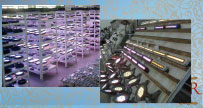
Testing method for SSL products
The SSL reliability is a multi-function, multi-disciplinary, multi-scaled, multi-technologies, multi-materials and multi-interfaces. Nowadays the “Trial-and-error” is mostly applied. It causes the long “time-to-market” without the guarantee of “first time right”. Due to lacking of the fundamental research upon the SSL reliability and modeling methods, it causes of about 3B (usd) losses.
Table. Available SSL product test methods
| Item | Standards | Description | Notes |
|---|---|---|---|
| Lumen maintenance | IES LM-80-08/Energy Star(ES) | About 6,000 hours lifetime test under 3 ambient temperatures, including 55, 85 degree of C and another one. | 10 samples for ES |
| Thermal cycling | Energy Star | Cycle: 2 min on/off each | 10 samples for ES |
| Lumen maintenance | IEC/PAS 62612 | 6,000 hours at 45 degree of C | 10 samples for ES |
| Fast thermal cycling | IEC/PAS 62612 | Cycle: 30 seconds on/off each | |
| Thermal shock | IEC/PAS 62612 | -10℃to 50℃, 5 shocks per hour |
In the MYPP of US DoE , the reliability is always one of the major tasks. In the MYPP of 2013, DoE indicates that the lifetime of SSL should not only consider the lumen maintenance, but also failure modes, such as colour shift. MYPP describe the development roadmap of the SSL system reliability modeling technology, including (1) collect and analyze the reliability data of the SSL product and components, (2) develop and verify the acceleration test method which consider the interactions between failure modes and (3) develop the lifetime prediction tools, and build the reliability database of LED and its key components (including LED packages, driver electronics, optics, and mechanical parts). DoE predict that the accuracy of the SSL lifetime prediction should be within 10% error in 2020. DoE established the LED system reliability consortium (LSRC), where the leading industries (such as GE, Cree, Philips, Osram) and academic institutes (such as Pacific Northwest National Laboratory, RTI, University of Maryland, Lamar Univerity) were involved. Moreover, DoE started the CALiPER program by testing the all kinds of SSL product by specified testing institutes. Although the original purpose is to terminate the bad products, it contributes massive data into the reliability database.
Meanwhile, the international leading lighting industries are planning global SSL reliability R&D strategy. Since 2010, Philips collaborate with more than 30 universities/research institutes/SMEs over Europe, Asia and America, under the open innovation framework. Moreover, Philips files the “Principal Component Reliability Testing for LED-based Products” proposal to IES together with other industries. Here they also define the reliability test method for LED optical materials.
From business point of view, a 6,000-hour test is not feasible to keep the “time-to-market”. The accelerated tests are available but need to be widely accepted.
